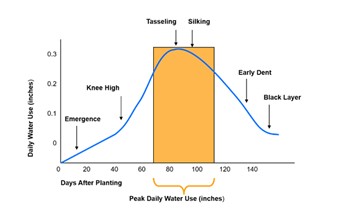Agri Innovations
New data on soil conditions and temperatures indicates farmers should prepare for high variability during 2022 harvest
Tue, 13 Sep 2022 09:35:42 CDT
 Golden Harvest agronomists anticipate high variability during 2022 harvest and offer actionable recommendations to scout and protect corn yield potential
Golden Harvest agronomists anticipate high variability during 2022 harvest and offer actionable recommendations to scout and protect corn yield potential
Golden Harvest released new data today that highlights how extreme weather conditions across the Midwest, such as intense heat, drought stress and other environmental factors, indicate corn harvest is likely to be highly variable in 2022. As farmers prepare for a challenging harvest in parts of the U.S., Golden Harvest agronomists have developed data-based insights and actionable recommendations to minimize yield loss and begin plans for next year.
Several factors led to increased variability this year. Wet planting conditions delayed planting in many areas, and fields planted in marginal soil conditions often see poorer root development, which can worsen the impacts of drought or heat that set in later in the growing season.
To manage variable conditions during harvest this season, Golden Harvest agronomists recommend scouting fields to determine the optimal time for harvest and begin planning for next season. Working with Golden Harvest Seed Advisors and agronomists to evaluate and understand which of the following factors were important this year can guide decisions for 2023 planting.
Evaluate potential drought impact
Drought conditions across the Midwest led to less grain fill time, earlier grain dry-down and poor nutrient uptake. Dry soil conditions can slow root growth and reduce the ability to transport nutrients into the plant. Research shows that drought stress during pollination can cause up to a 50% loss in yield, whereas just prior to or just after this crop stage period, drought yield loss ranges from 20% to 25%.1
“In extended dry periods, corn plants simply run out of steam with reduced nutrient and water uptake from the soil,” says Blake Mumm, Golden Harvest agronomist in central Nebraska. “We’re anticipating seeing reduced grain fill and yield loss in a lot of fields this year due to drought over the summer.”
If drought impacted fields, look out for rolling plant leaves, which reduces transpiration and conserves plant moisture. If leaf rolling is observed for 12+ hours a day, yield loss during harvest is more likely to occur, according to Mumm.
Prepare for yield loss from extreme heat
Extreme heat plays a separate but important role in grain development and yield potential. Higher temperatures toward the end of the pollination stage or early weeks of grain fill can result in tip kernels aborting. Increased temperatures overnight are usually accompanied by higher-than-average daytime temperatures and drier soil moisture levels. Data shows a 2.8 to 4.7 bushel per acre yield decline for every 1° F increase in July and August average night temperatures.
“Drought and heat are often linked. But even in fields that received adequate rainfall, heat by itself can deteriorate exposed silks, resulting in poor pollination of ear tips,” says Andrew Rupe, Golden Harvest agronomist in east central Iowa. “Several areas that have gotten timely rainfall are seeing significant tip back on ears due to the heat. However, cooler temperatures and rainfall during grain fill can help lengthen this period, leading to increased kernel depth, size and weight. I recommend monitoring temperatures throughout the day and night to anticipate how fields will be impacted.”
Select the best products for your fields
Golden Harvest Agronomist Ryan Dunsbergen, who covers southern Iowa, underscores that the most important way farmers can manage increasingly variable conditions is to continue scouting and monitoring and planting the right hybrid for the right acre. Dunsbergen recommends the following Golden Harvest® hybrids based on field conditions:
1. Fields where drought is likely: Golden Harvest corn hybrids G00A97, G10L16, G11V76 and G16Q82 offer proven consistent yields across drought stricken areas due to their ability to protect yield potential under drought conditions.
2. Fields where drought and heat are likely: Golden Harvest hybrids G15J91 and G16Q82 offer above-average late season stalk strength and are less likely to experience lodging when nutrient deficiencies occur.
Make plans for 2022 harvest and 2023 planting
To discuss your fields and harvest plans, contact your Golden Harvest Seed Advisor today. For more tips and strategies, Golden Harvest offers a library of agronomy articles with actionable data and local insights to help precisely place products for maximized performance in farmers’ fields. The Agronomy in Action 2022 Research Review provides a comprehensive review of applied and practical agronomic studies conducted during the 2021 growing season at Golden Harvest Agronomy in Action research sites.
To find better solutions for your corn and soybean acres, contact a Golden Harvest Seed Advisor at GoldenHarvestSeeds.com.
WebReadyTM Powered by WireReady® NSI




